Catalogue No. 7 (E-List) - Recent Acquisitions (February 2020)
How to order
Email: underthehillbooks@gmail.com
Terms of payment
All major credit cards and Paypal accepted. Please inquire if further details are needed. Items may be returned for any reason, upon notification by email, within seven days of receipt (return shipping is the responsibility of the customer). Libraries and institutions may apply for deferred billing.
Terms of shipping
Postage is additional, and items can be shipped via USPS or UPS.
Robert Hoe’s copy of a scarce Kelmscott Press title
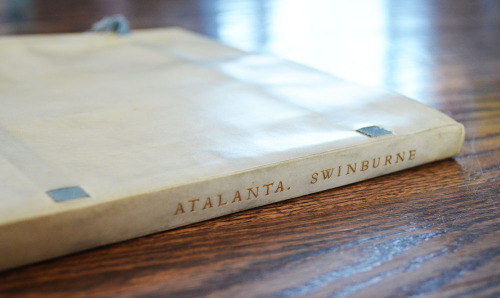
1) Swinburne, Algernon Charles. Atalanta in Calydon. A Tragedy. Hammersmith: Kelmscott Press, 1894. One of 250 paper copies, out of a total of 258 copies. Printed in red and black in Troy, Chaucer, and Golden type, with the dedication and quotation from Euripides in Greek type designed by Selwyn Image. Woodcut title spread. Decorative woodcut borders and initials. Original full limp vellum lettered in gilt on spine. Original ribbon ties. Auction cataloging slip tipped in. The copy of Robert Hoe (1839-1909), with his bookplate. Additional bookplates of private press collectors Brian Douglas Stilwell and Richard Friedlander (1939-2014), representing an excellent line of provenance. Housed in a straight grained morocco pull-off case, titled in gilt. Measures approx. 8.25" x 11.5". Covers lightly browned with some marks, and the top tie on the front cover has broken. Pull-off case is worn and the top portion has been repaired.
“When Atalanta (which was first published in 1865) was printed by Morris, Swinburne wrote to him that it was ‘certainly one of the loveliest examples of even your incomparable press’…Morris’s own comment, in a letter to Theodore Watts, 9 August 1894, was ‘I like the look of the volume very much’…This is the only K[elmscott] P[ress] book in which Morris used a type not designed by himself. During 1892, Selwyn Image, with the technical assistance of Emery Walker, designed a Greek type based on a certain tenth century MS in the B. Museum, and on a Spanish printed book there of the fifteenth or early sixteen century, which was itself founded on a MS of the 10th century’” (Peterson).
SOLD
A beautiful copy of one of the Elston Press’ smallest limitations
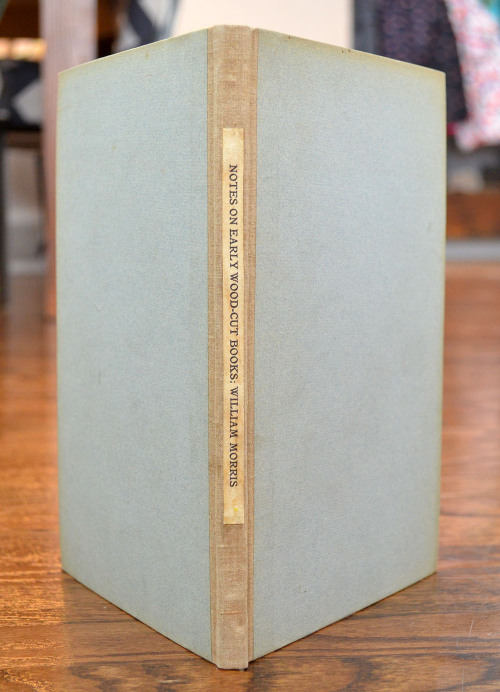
2) Morris, William. Some Notes on Early Woodcut Books, with a Chapter on Illuminated Manuscripts. New Rochelle, NY: The Elston Press, 1902. Hardcover. Limited edition of 120 copies, printed by Clarke Conwell. Colophon printed in red. Printed on handmade paper, watermarked “Elston”. Light blue paper-covered boards with linen spine and paper label to spine. Measures approx. 6.75" x 9.75". Some light fading to edges of boards, and some browning to spine label. Light browning (remnants of bookplate) to front pastedown.
“The most important of the New York private presses was in a suburb. The Elston Press began in Manhattan in 1900, but its owner, Clark Conwell, moved it to New Rochelle in 1901. Conwell, with the aid of his designer and wife, Helen Marguerite O'Kane, was one of the most brilliant of the Kelmscott disciples. His books exemplify the best in the private press spirit: with traditional models as a point of departure, they achieve freshness of their own. They were printed by handpress in limited editions on handmade paper and Japan vellum, bound in boards or cloth or vellum with ties” (Thompson).
SOLD
Margaret Stillwell’s first publication

3) Stillwell, Margaret Bingham. The Influence of William Morris and the Kelmscott Press, as Shown by an Exhibition of Books. Providence, R.I.: Press of E. A. Johnson & Co., 1912. Title continues: …from the Later English Presses at the John Carter Brown Library in December, 1911. "Reprinted, with a few changes, from the Brown Alumni Monthly for March, 1912". Wraps. Printed on handmade paper. Measures approx. 4.75" x 6.25". Slight browning to edges.
“Margaret Bingham Stillwell (1887-1984) was an American librarian and bibliographer who spent most of her professional career as curator of the Annmary Brown Memorial. Stillwell entered Pembroke College in Brown University in 1905, beginning work at the John Carter Brown Library as a student, and graduated in 1909. In 1914 she moved to the New York Public Library as a cataloguer of early Americana and in 1917 she returned to Providence as curator of the Annmary Brown Memorial Library, where she worked until her retirement in 1953. The library, initially a private collection, was transferred to Brown University in 1948, at which time Stillwell became professor of bibliography. Although she was the first woman appointed to a full professorship at Brown, she never received a full professor’s salary. Stillwell specialised in the bibliography of incunabula…and her survey Incunabula in American Libraries: A Second Census of Fifteenth-Century Books Owned in the United States, Mexico, and Canada (New York: Bibliographical Society of America, 1940) became known eponymously as Stillwell. Stillwell was a member of the Hroswitha Club of American women book collectors, and in 1977 she became the first female honorary member of the Grolier Club” (Wikipedia)
SOLD
A rare example from Mary Moulton Cheney’s Artcraft Shop
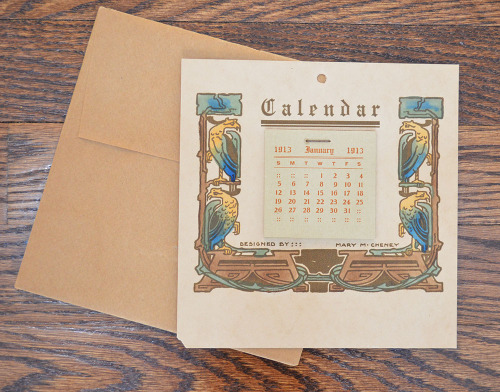
4) Calendar for 1913, designed by Mary Moulton Cheney. [The Artcraft Shop, 1912.] Beautiful arts and crafts design, surrounding an unused 1913 calendar (all months intact), featuring a hand colored design of peacocks, trees, and decorative elements. Includes original envelope. Measures approx. 6.25" x 6.5". Small chip to lower left corner. Envelope worn at edges, with crease in flap.
“Cheney…started her own studio [in 1897]. She opened a printmaking shop with Mary Marsh Smith named The Artcraft Shop: Sign of the Bay Tree. They produced a variety of different items including clothing tags, calendars and greeting cards. … Beyond her own work and involvement with the Minneapolis College of Art and Design, Cheney was also extremely active with the artistic community in Minneapolis. [She] ‘seems to have served as founder, leader, or both, for almost every early arts organization in Minneapolis, as well as the Minnesota State Art Society'” (Wikipedia).
SOLD
A stunning example of Arts & Crafts bookmaking by M.M. Cheney
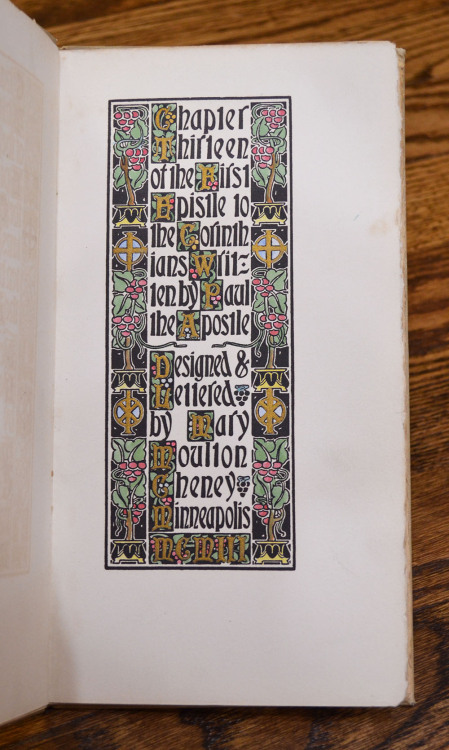
5) Chapter Thirteen of the First Epistle to the Corinthians Written by Paul the Apostle. Minneapolis, MN: Mary Moulton Cheney, 1903. Limited to 500 copies, of which this is #377. Signed by Cheney on the limitation page. Printed on thick Stratford handmade paper by Hahn & Harmon and bound in cloth by A.J. Dahl & Co. Tan cloth with design on front cover in blue, green and gilt of doves, cross, and grapevines on front cover. Design printed in blue and green on rear cover. Stunning arts & crafts lettering and designs by Cheney on each page, all of which have been colored by hand in green, red, blue, brown, yellow watercolors, along with accents in gilt. 14 unnumbered pages. Measures approx. 5 x 9.5". Marks to upper rear cover, and some spots and browning to pages.
Along with May Smith, Moulton Cheney was one half of the Chemith Press in Minneapolis, which was also producing volumes around this time. The Chemith Press was the first American private press of the arts & crafts period–and is believed to be one of two total–that was run by women (The Origins of Graphic Design in America, 1870-1920, Raffel & Thomson, 1997).
This title is number 66 in the Jean-Francois Vilain and Roger S. Wieck Collection, exhibited in the catalogue Across the Spectrum: Color in American Fine & Private Press Books, 1890-2015.
SOLD
Manuscript by Sydney Bolton Russell, father of Gordon Russell, and closely connected to the Guild of Handicraft

6) [Sydney Bolton Russell.] The Wonderful Christmas Story Told by St. Luke. Colophon (in ink) reads: “Written for Miss Ellen D. Sharpe by her friend S. B. Russell at Snowshill, on the Cotswolds, in November 1928.” Top edge gilt. Bound in a full crushed blue morocco with gilt title to front cover. Gilt-tooled turn-ins, marbled endpapers, top edge gilt. 15 pages, all hand written in fine calligraphy in black and red ink by Russell. Two printed illustrations pasted in. Measures approx. 7.5" x 11". Some light rubbing to corners.
Sydney Bolton Russell was closely connected to the Guild of Handicraft, and the father of Gordon Russell, the English designer and craftsman. “[Gordon Russell] came under the influence of the Arts and Crafts movement from 1904 after his father [Sydney Bolton Russell] had moved to Broadway in the Cotswolds to be hotelier at the Lygon Arms, through the Guild of Handicraft, the community of metalworkers, enamellers, wood carvers, furniture makers, and printers brought in 1902 by C. R. Ashbee [founder of the Essex House Press] from east London to Chipping Campden” (Wikipedia).
Ellen D. Sharpe was the member of a prominent Providence, RI family, and made substantial donations to the Rhode Island School of Design (RISD).
SOLD
The first UK edition, printed at the Merrymount Press in 1896

7) Andersen, Hans Christian. The Nightingale. Birmingham: G. Napier and Co., 1896. Printed at The Merrymount Press. First UK edition, published in the same year as the first U.S. edition. Title page and four illustrations by Mary J. Newill, one of the illustrators connected with the Birmingham Guild of Handicraft. Printed on Arnold handmade paper, watermarked “1895”. French fold pages. Unlike the U.S. edition, which was bound with a fragile paper loosely covering the boards and is rarely seen without the spine perished, the UK edition was bound in standard paper-covered boards, and thus here the spine remains intact. Measures approx. 7" x 8.75". Some browning to edges of covers. Wear to spine tips. 5 gatherings of the French fold pages have been split; 8 remain as issued.
SOLD
A scarce example of bookbinding from the Birmingham Guild of Handicraft
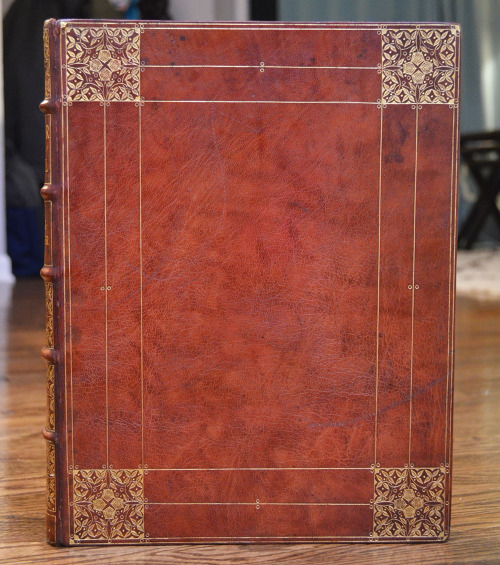
8) [Birmingham Guild of Handicraft]. Gardiner, Samuel Rawson. Oliver Cromwell. London: Goupil & Co., 1899. Limited to 1475 copies, of which this is #1090. Frontis portrait in color and numerous engraved plates, all with tissue guards with letterpress captions. Bound by the Birmingham Guild of Handicraft in full sienna sealskin arts & crafts binding, with double interlocking gilt rules across the front cover and four gilt quatrefoils in each corner, decorated with leaves and tudor roses. Double gilt ruled borders on lower board. Five raised bands to spine, with gilt title, date, and continuation of the cover motif in 4 compartments. Dentelles with single example of floral decoration in gilt to corners. Top edge gilt. Measures approx. 10" x 13". Slight scratch to lower right front cover, light rubbing to edges. Some spots to covers.
Sealskin is most well known as an arts & crafts-era bookbinding material by The Doves Bindery, and is put to use here in a similar, striking effect. "The sealskin used [by The Doves Bindery] ranges in colour from orange to brick-red or terracotta, and some of the skins were probably specially selected by Cobden Sanderson for their attractive blotchy appearance" (Tidcombe, p. 94).
“The Birmingham Guild was established in 1890, its founder member being Arthur Stansfield Dixon. It originated as a semi-autonomous group with the Birmingham Kyrle Society. By 1895 the Guild had formed its own independent workshop and became a limited company. Circa 1894 the Guild began producing books under the imprint ‘The Birmingham Guild of Handicraft Press’. … Designers and artists associated with the Press included Arthur J. Gaskin, Mary Newill and Charles March Gere. The Guild was closely associated with Birmingham School of Art, many of the designers and craftspeople who worked for the company either trained or taught at the School. … Other designers associated with the shop included Albert Edward Jones, George T. Tarling, Claude Napier Clavering, Charles Llewellyn Roberts, and Thomas Birkett. The Guild participated in the exhibitions of the Arts and Crafts Exhibition Society in London in 1893, 1896, 1899, 1903 and 1906” (Artist Biographies Ltd).
SOLD
Printed for the bookbinder Sarah T. Prideaux, in rare jacket
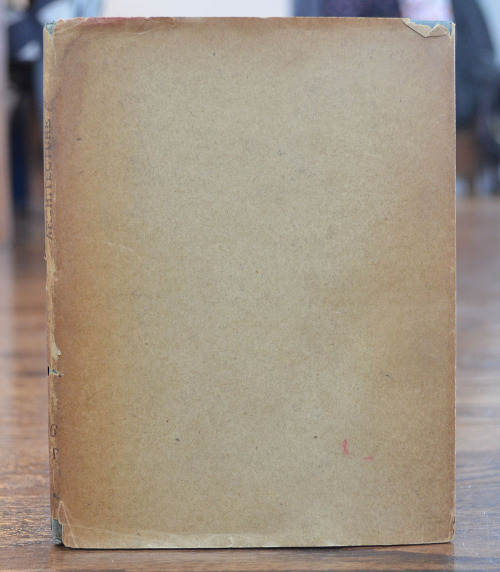
9) Wotton, Sir Henry Kt. The Elements of Architecture, Collected by Henry Wotton Kt from the best Authors and Examples. London: Longmans, Green, and Co, 1903. Limited edition, one of 350 copies reprinted from the first impression (1624). Printed at the Chiswick Press with the ornaments designed by Herbert P. Horne for S.T. Prideaux. Printed on handmade Hammer and Anvil paper. Blue paper covered boards with paper spine label. Additional spine label bound in at front. Very scarce brown paper dust jacket with title in black to spine. Measures approx. 5.75" x 7.5". Corners a bit bumped and spots to spine tips. Edgewear, small chips, and browning to dust jacket. Gift inscription. A beautiful arts & crafts production.
“Herbert Percy Horne (1864 in London–1916 in Florence, Italy) was an English poet, architect, typographer and designer, art historian and antiquarian. He was an associate of the Rhymers’ Club in London. He edited the…The Hobby Horse for the Century Guild of Artists” (Wikipedia).
“While in Florence, Horne, too, continued his interest in book and type design. He collaborated with bookbinder Sarah Prideaux, designing her 1903 publication of The Elements of Architecture by Sir Henry Wotton…” (OAC).
SOLD
The first book printed by Dard Hunter, and the first ever “one man book”
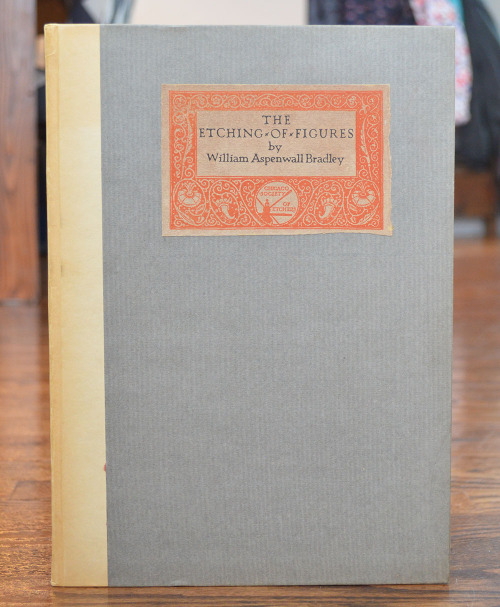
10) Bradley, William Aspenwall. The Etching of Figures. Printed by Dard Hunter at Marlborough-on-Hudson, 1915, produced on his handmade paper and printed by his hand with his own designed, cut, and cast type. Produced as a keepsake for the Chicago Society of Etchers, and limited to 250 copies. The binding of the book was the only portion not completed by Hunter–it was bound by the Oakwood Binders, the bindery run by ex-Roycrofters Peter Franck and Sterling Lord. Red initials. Grey blue paper-covered boards with decorative printed label to front cover and Japan vellum spine. “Active Members of Chicago Society of Etchers” leaflet loosely inserted. Measures approx. 7.5" x 11.25". Some browning to spine and light browning page edges.
Bookplate of Harry C. Goebel. A tipped-in note mentions that the etching by William Auerbach-Levy that accompanied the volume was placed into the Print Collection of Harry C. Goebel (1893-1969). This collection of 1,315 prints is now housed at Warner Memorial Library at Eastern University (link). The volume Selected Prints from the Goebel Collection at Eastern College is included with this volume.
“In an exhaustive study of paper-making and typography, Mr. Hunter has never seen mention of a book produced in which paper, type and printing were the work of one man as they are in the present volume” (foreword).
SOLD
One of 60 copies produced by Officina Bodoni
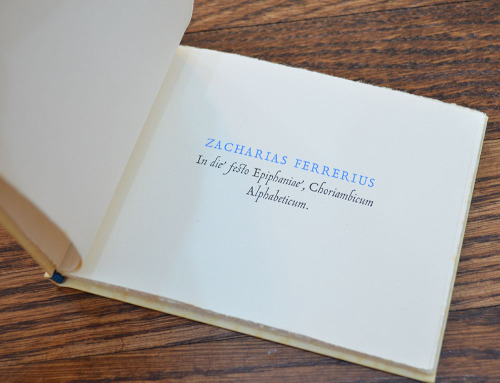
11) Ferrerius, Zacharias. In Die Festo Epiphaniae, Choriambicum Alphabeticum. (Verona: Officina Bodoni, 1968). One of 60 copies privately printed [unstated] by G. Mardersteig with Arrighi initials and types “for his friends in USA.” Calligraphic initials from Vicentino’s 1523 writing book are printed in blue. Vellum paper boards, paper slipcase. Loosely inserted is a blank card, signed by Giovanni Mardersteig and his son, Martino. Schmoller & Mardersteig 159. Japan vellum boards with paper label to spine and house in paper slipcase. Measures approx. 4.5” x 3.5". Some light foxing to covers.
SOLD
A beautiful miniature embroidered binding

12) Drinkwater, John. The Way of Poetry. Collins Clear Type Press, no date, but circa 1920s. Portrait frontispiece. Title page has been hand-colored. Bound in aquamarine cloth with embroidered flowers and ribbon to front cover. “Swirling” design in gilt drawn on cloth. Brass tips to corners of both boards. Light blue paper pastedowns. Measures approx. 2.75" x 4". Some browning to pages, and light wear at inner hinges.
SOLD
Seven Grolier Club exhibition catalogues (1894-1917) with associated ephemera
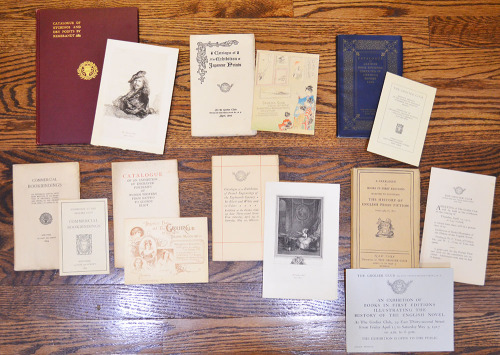
13) Grolier Club Exhibition Catalogues (7) with related Club-issued Ephemera Included are the catalogues listed below along with unique related ephemera issued by the Grolier Club, all of it scarce. Some light wear to catalogues.
-Commercial Bookbindings: An Historical Sketch (1894)
-Catalogue of an Exhibition of Engraved Portraits of Women Writers from Sappho to George Eliot (1895)
-Catalogue of an Exhibition of Japanese Prints (1896)
-Catalogue of Etchings and Dry Points By Rembrandt (1900)
-Catalogue of an Exhibition of French Engravings of the Eighteenh Century (1905)
-Catalogue of Ornamental Leather Bookbindings Executed in America Prior to 1850 (1907)
-Catalogue of Books in First Editions Selected to Illustrate the History of English Prose Fiction from 1485 to 1870 (1917)
SOLD
Notices for four Grolier Club annual meetings: 1901, 1911, 1915, and 1924
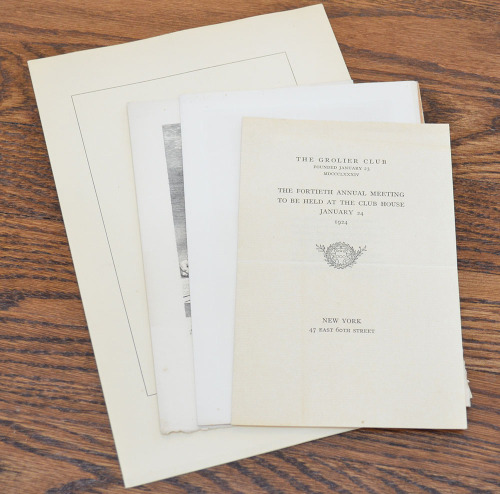
14) Grolier Club Annual Meeting Notices (4). Included are the following notices sent out to Grolier Club members for the annual meeting, held every January.
-Annual Meeting on Jan. 24, 1901
-Annual Meeting on Jan. 26, 1911
-Annual Meeting on Jan. 18, 1915
-Annual Meeting on Jan. 24, 1924
Further details on each meeting notice is available here.
SOLD
Nineteen pieces of rarely-seen Grolier Club ephemera: 1892-1927
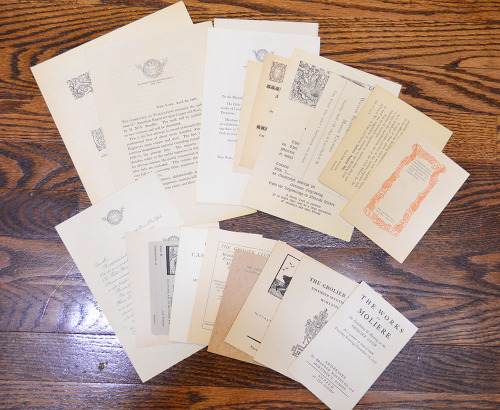
15) Miscellaneous Grolier Club Ephemera, 1892-1927 (19 items). An excellent collection of Club-issued ephemera, including admission cards, announcement notices, prospectuses, etc. Undoubtedly collected by an early Grolier Club member.
A full list of the ephemera is available here.
SOLD
The smallest limitation of any of William Loring Andrews’ publications
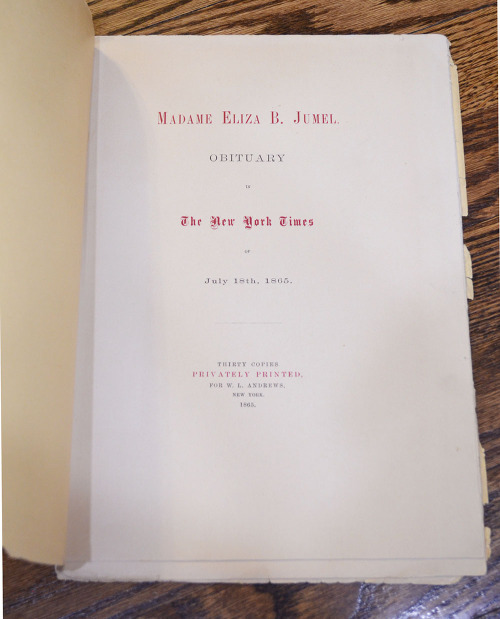
16) [William Loring Andrews]. Madame Eliza B. Jumel. Obituary in The New York Times of July 18th, 1865. Privately printed for W.L. Andrews, 1865. Limited to 30 copies, of which this is #2, hand-numbered by Loring Andrews with his initials on the copyright page. Plain contemporary wrappers. 16pp. Measures approx. 7.75" x 11.25". Some soiling, stain to the front cover, and chipping to edges.
Owner’s signature of Henry B. Dawson on the dedication page; Dawson (1821-1889) was an editor of pro-temperance journals, and in 1863, wrote an introduction and notes for a new edition of The Federalist, which ended up offending both the Hamilton and Jay families (link).
“[The Obituary] made a pamphlet of only sixteen pages, but I think it still, as I considered it then, an interesting memorial of one of the most remarkable female characters connected with New York history” (Andrews, Gossip About Book-Collecting).
“The penniless beauty Eliza Bowen acquired a life of luxury upon her marriage to Stephen Jumel, a wealthy French wine merchant who bought the elegant Morris Mansion for her in 1810. … Allegedly a former prostitute, she was shunned by New York society, but met with a warmer reception when the Jumels traveled to France. There she charmed Emperor Napoleon Bonaparte, who bestowed various gifts upon her, including several pieces of furniture which may still be seen in the Morris-Jumel Mansion [in Manhattan]. The Jumels’ marital affections ended long before their marriage, however, and her reputation became even more notorious when her husband died in 1832 and rumors persisted that she had deliberately let him bleed to death. Unfazed by public opinion, a year later the merry widow married Aaron Burr, the former United States Vice President who was infamous for his killing of Alexander Hamilton. She sued Burr for divorce soon afterwards, however, claiming that he was a fortune-hunter. … Reverting to her former married name, Madame Jumel lived in style until her death at age 90 in 1865” (Nikita Barlow).
SOLD
Limited to 300 copies issued by the Grolier Club, with scarce prospectus laid in
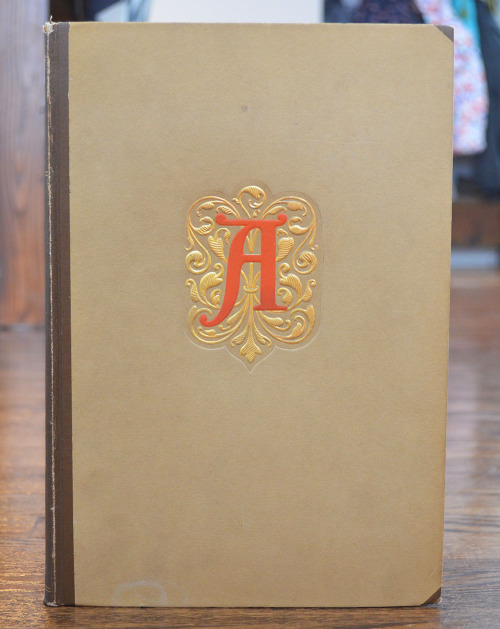
17) Hawthorne, Nathaniel. The Scarlet Letter. New York: The Grolier Club, 1908. Limited to 300 copies on paper from the second edition of the title and printed on Rives handmade paper. Illustrated by George H. Boughton with 13 plates in two states, black & white and color, and separated with a tissue guard. Ribbed cloth spine and tan paper covered boards with gilt text and rules on the spine and a red embossed letter “A” surrounded by gilt decorations on the front board. Loosely inserted is the Grolier Club-issued prospectus, featuring the first appearance of 16-point Lindsay type and color printed initial “A” that is used as the opening initial on page 59. Measures approx. 7.5" x 11". Some rubbing and edgewear to the covers and spine. Upper spine tip repaired.
“In the preparation of this book, undertaken at the special request of a large majority of the members of the Club voting on the question of re-issuing an important work by an American author, the Committee has taken greater pains than have been found necessary in any other publication, and has encountered more difficulties than have beset any other of the works it has had in hand. The Committee feels, however, that the result fully justifies all the trouble and delay, and is confident that the book, both its letter-press and illustration, will merit the cordial approval of the members of the Club” (prospectus).
SOLD
Bound at Donnelley, along with original Grolier Club admission card
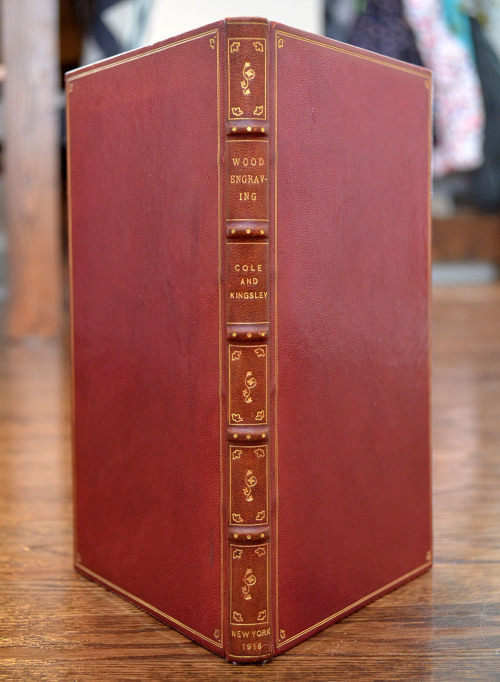
18) Wood-Engraving: Three Essays by A.V.S. Anthony, Timothy Cole and Elbridge Kingsley, with a List of American Books Illustrated with Woodcuts. New York: The Grolier Club, 1916. Limited to 260 copies. Essays include: Mr. Anthony’s “An Art That Is Passing Away”; Mr. Cole’s “The Analogy Between Wood-engraving and Painting”, and Mr. Elbridge’s “Memories of Wood-engraving”. Following the above essays, American books illustrated with woodcuts exhibited at the Grolier Club from April 8 to May 8, 1915 are listed. Loosely inserted is an original Grolier Club admission card for this exhibit, featuring an engraving by Robert Hoskin. Bound in full burgundy morocco by the School of Apprentices at R.R. Donnelley & Sons, with gilt ruled covers and decorated spine. Wide turn-ins with five gilt rules, and reddish orange marbled endpapers. Measures approx. 6" x 9". Light discoloration to spine and some small spots of rubbing to edges.
SOLD
The pirated third edition of Leaves of Grass in a full morocco binding
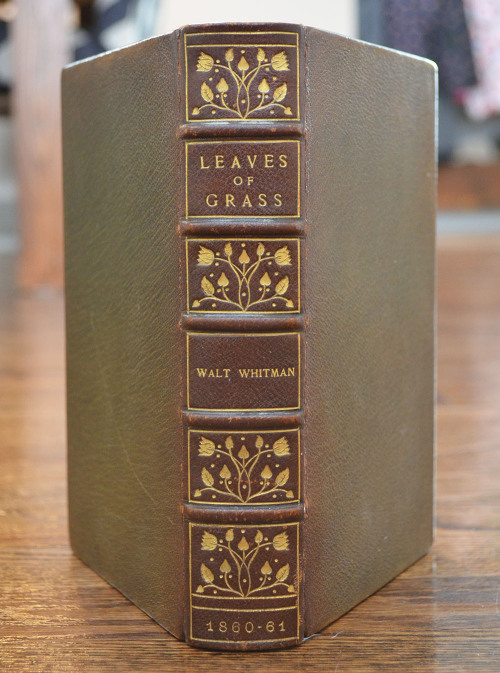
19) Whitman, Walt. Leaves of Grass. Boston: Thayer and Eldridge, 1860. [Richard Worthington, post-1879.] The presumed third printing (though previously thought to be the second), and first unauthorized printing, of the third edition, without the printers’ imprints on the copyright page. Myerson, Walt Whitman, a Descriptive Bibliography, A2.3.c (calling it the third printing); BAL 21397 (calling it the second printing). Frontispiece portrait of Whitman; an engraving by Stephen Alonzo Schoff from an oil painting portrait by Charles Hine. Dated on the title page as the third edition (“Year 85 of the States”). The poems are arranged in 7 “clusters”: Chants Democratic and Native American, with introductory poem Apostrophe; Leaves of Grass; Enfans d'Adam; Calamus; Messenger Leaves; Thoughts; Says; Debris; and 26 individual poems including Walt Whitman, A Word Out of the Sea (later titled Out of the Cradle Endlessly Rocking). The volume commences with Proto-Leaf (which was later called Starting from Paumanok). Bound in full olive green morocco by the Adams Bindery, with four of six spine compartments decorated with leaves, tulips, and gouges in an arts & crafts design. Elaborate turn-ins in the style of Roger Payne, along with lightly mottled endpapers. Measures approx. 5" x 7.5". Spine darkened to brown, and some rubbing to edges and hinges.
SOLD
An excellent example of Zaehnsdorf’s “a la répétition” binding design
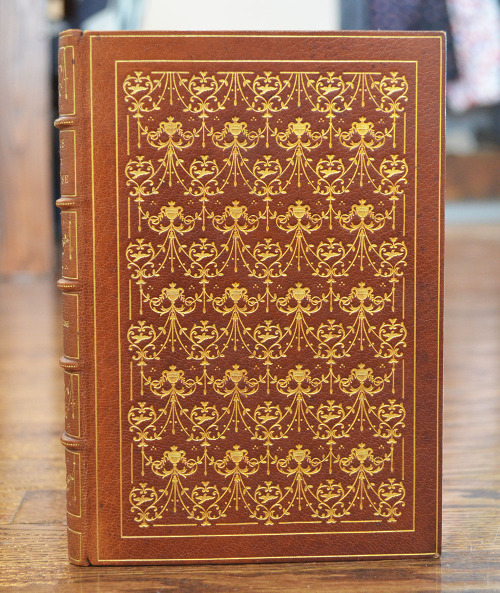
20) Swinburne, Algernon Charles. Songs Before Sunrise. London: F.S. Ellis, 1871. First edition. (No ads bound in at rear, so state is undetermined.) Bound by Zaehnsdorf in full russet brown morocco with an elaborate diapered pattern on both covers, built up with an urn, vines, leaves, dots, and doves. Five bands to spine, with similar design included in four of six compartments. Elaborate turn-ins, created with leaves and gouges and a duo of doves stamp. Zaehnsdorf “exhibition” stamp at rear. Light green marbled endpapers. Top edge gilt. Large bookplate on front pastedown of Leonard Noble. Measures approx. 5.25" x 7". Light fading to spine, and some small spots to upper rear cover.
SOLD
Striking arts & crafts binding executed for Bumpus

21) Swinburne, Algernon Charles. Poems and Ballads. Chatto & Windus, 1899. Bound in dark brown morocco for Bumpus with a beautiful arts & crafts pattern to the front cover and spine, made up of narrow leaves, flowers, stems (in the form of gouges), and a dot pattern to the inner front cover. Continuation of floral and leaf design to five compartments of spine, with title and author in the second compartment. All page edges gilt with gauffered pattern along each edge. Ruled turn-ins with floral decoration at corners. Based on the style of decoration and tooling, the binding was likely executed by Riviere & Son for Bumpus. Housed in grey buckram slipcase. Bookplate by C.W. Sherborn for Gwendolen Bourke on front pastedown. Measures approx. 4.75" x 7.5". Spine lightly faded. Corners of rear cover bumped. Foxing to pages.
SOLD
Skillfully executed binding in blind by J.W. Menzies of Manchester
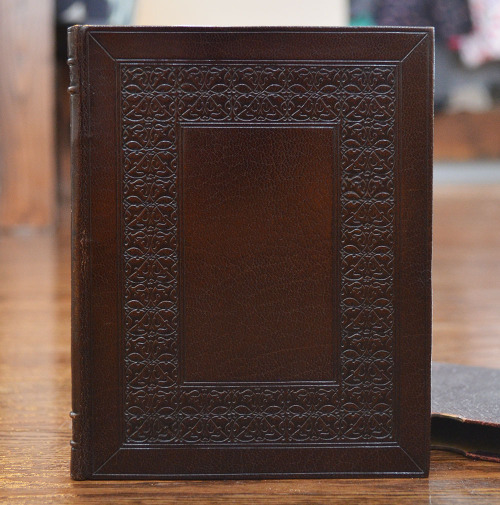
22) Eca de Queiroz, Jose Maria de. The Sweet Miracle. London: David Nutt at the Sign of the Phoenix, 1905. Third edition. Printed on handmade paper. Frontispiece sketch by the King of Portugal. The prominent Portuguese realist’s devotional prose poem, occasioned by his tour of Palestine; translated by Edgar Prestage. Bound in full dark brown morocco by J.W. Menzies, with large blind-stamped border on both covers. Two bands at top and bottom of the spine in the style of the French, with gilt title and author. Light brown marbled endpapers. Top edge gilt. Housed in full leather slipcase. Measures approx. 5" x 6.5". A lightly rubbed portion to binding at “pull-out” (based on the slipcase cutout). Slipcase worn at edges.
An elaborate binding by “Mr. W. Menzies, instructor in binding at the [Manchester] Municipal School of Technology…” (link) is mentioned in an article of “The Studio” in 1915.
SOLD
Inlaid binding in the style of the Guild of Women Binders
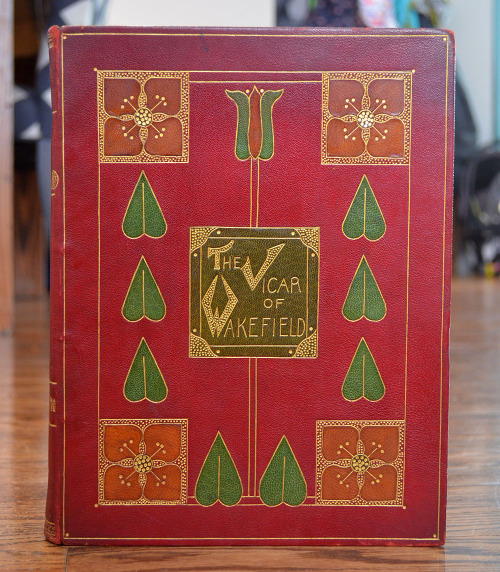
23) Goldsmith, Oliver. The Vicar of Wakefield. Adam & Charles Black, 1903. Limited to 250 copies, of which this is #115. Signed by the published. Including John Forster’s essay on the story, and containing thirteen facsimile illustrations in colour by John Massey Wright, a pupil of Thomas Stothard; frontis and 12 tissue-protected color plates. Bound in full crimson calf, reminiscent of some of the more esoteric work of the Guild of Women Binders, with inlaid kelly green ornaments, light brown flowers with stippled ornamentation in each corner, and a dark green center ornament featuring a hand-tooled and stippled title. Smooth spine features hand-tooled title and author and stamps in blind. Light blue marbled endpapers. Small bookseller’s sticker on front pastedown. Measures approx. 8 3/8" x 10 ¾". Light rubbing to the edges and spine tips. Corners are bumped and lightly worn.
SOLD
“We are aware of only two other examples of Cedric Chivers bindings with Rackham panels sold at auction…” (Doyle New York, 2011)
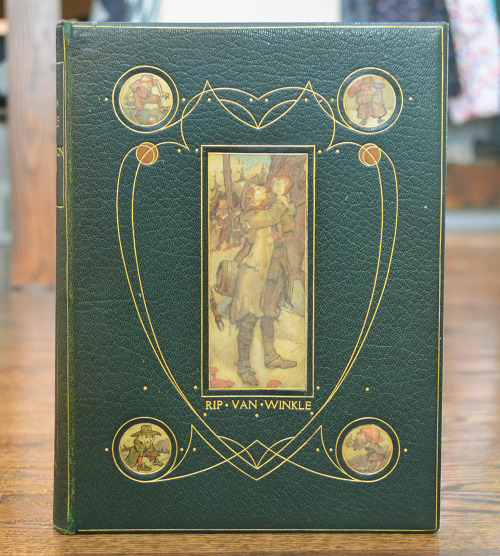
24) Irving, Washington. Rip Van Winkle. London: William Heinemann, 1905. First edition. Color frontispiece and 50 color plates mounted on brown paper with captioned tissue guards, black and white illustrations in the text, all by Rackham. Bound by Cedric Chivers of Bath (stamp-signed on rear turn-in) in full blue-green morocco with two circular green morocco onlays and a rectangular vellucent panel in the center (4 ½" x 1 7/8"), featuring a watercolor drawing depicting Rip Van Winkle, framed by gilt and with four vellucent medallions (1" in diameter) in the corners featuring watercolor drawings from various Rackham color plates. Single line gilt border on covers, heart-shaped gilt design on back. Smooth spine decoratively tooled and lettered in gilt. Gilt ruled turn-ins, marbled endpapers. Measures approx. 7.25" x 9.75". Some rubbing to edges and corners, light fading to spine. Some rippling & light browning to the translucent vellum of main panel. 3 of the 4 medallions feature similar browning to the vellum. Some foxing to tissue guards.
Though it is unknown which artist created the vellucent panels after Rackham, “in his large bindery at Portway, Bath, Chivers employed about forty women for folding, sewing, mending, and collating work, and in addition, five more women worked in a separate department, to design, illuminate, and colour vellum for book decoration, and to work on embossed leather. These five were Dorothy Carl[e]ton Smyth, Alice Shepherd, Miss J.D. Dunn, Muriel Taylor, and Agatha Gales. Most Vellucent bindings were designed by H. Granville Fell, but the woman most frequently employed for this kind of work was probably Dorothy Carl[e]ton Smyth” (Tidcombe, Women Bookbinders 1880-1920).
SOLD
Folio binding in pull-off case from Alfred de Sauty at R.R. Donnelley
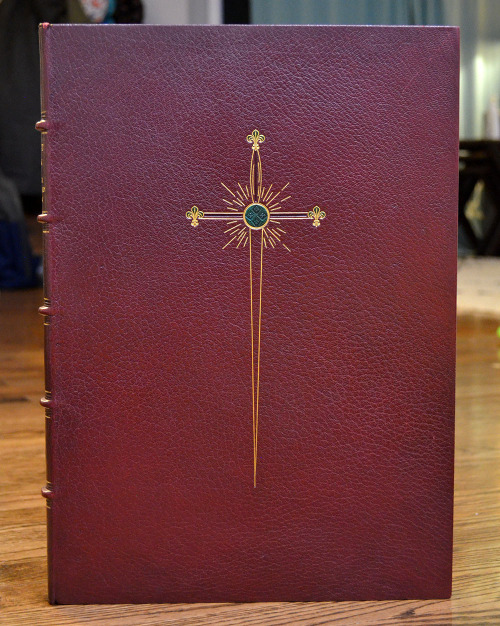
25) Shaw, George Bernard. Saint Joan. A Chronicle Play in Six Scenes and an Epilogue. Illustrated with 16 mounted and titled color and sepia sketches and stage settings by Charles Ricketts. One of 750 copies printed by R. & R. Clark on watermarked Batchelor handmade paper. Bound in full burgundy morocco by R.R. Donnelley & Sons, Chicago with gilt central motif of a sword with green morocco black-stamped inlays to both covers. Spine ruled, tooled and lettered in gilt in compartments, with five raised bands. Turn-ins tooled in gilt. Top edge gilt. Housed in matching custom quarter morocco pull-off case, made with original board papers. Some plates with creases at corner (common for this title). Folio; measures approx. 10.75" x 15.5". A few minor spots of rubbing to binding, but overall, a beautiful copy. Pull-off case has marks to paper covers and wear to spine.
“For thirteen years [1923-1935], the Extra Bindery [at Donnelley] was headed by the distinguished English bookbinder Alfred de Sauty, who was recruited by T. E. Donnelley from the Central School of Arts and Crafts in London. De Sauty immediately set the standard for American bookbinding when he hired three European-trained bookbinders, William Anson, Basil Cronk, and Leonard Mounteney. As was the European tradition, hand-binding at RR Donnelley was a team effort. The head of the bindery generally established the design and specified the materials. From there, a book passed through the hands of several staff members, each responsible for a particular aspect of the process; sewing, backing, tooling, and finishing” (University of Chicago Library).
SOLD
